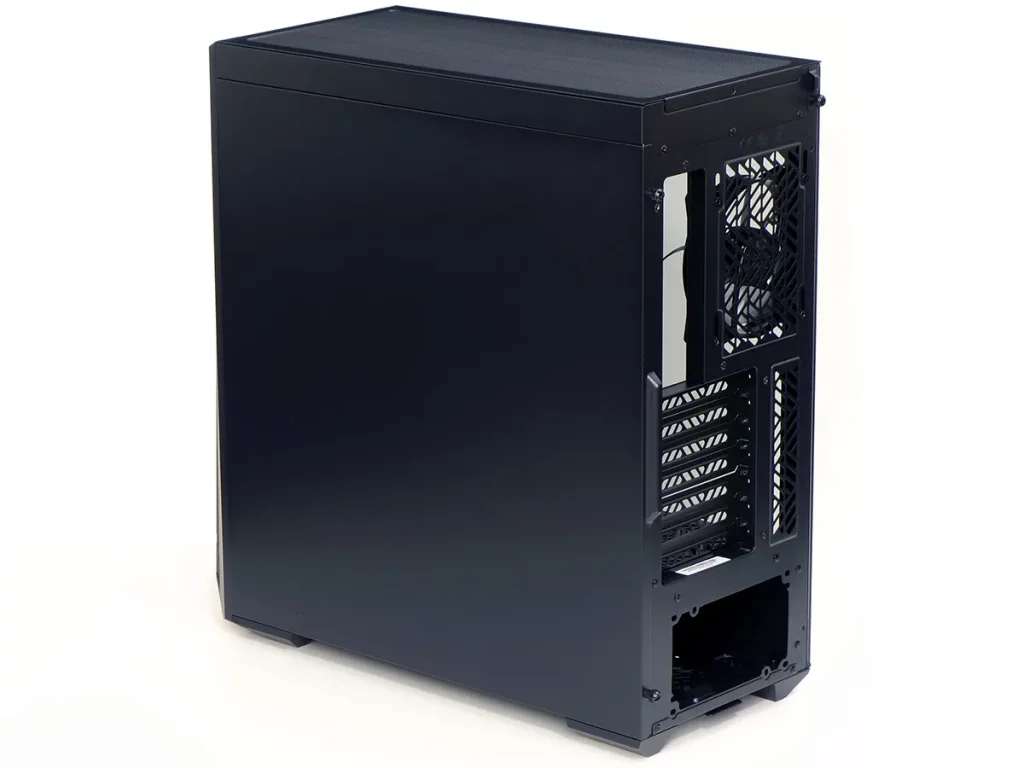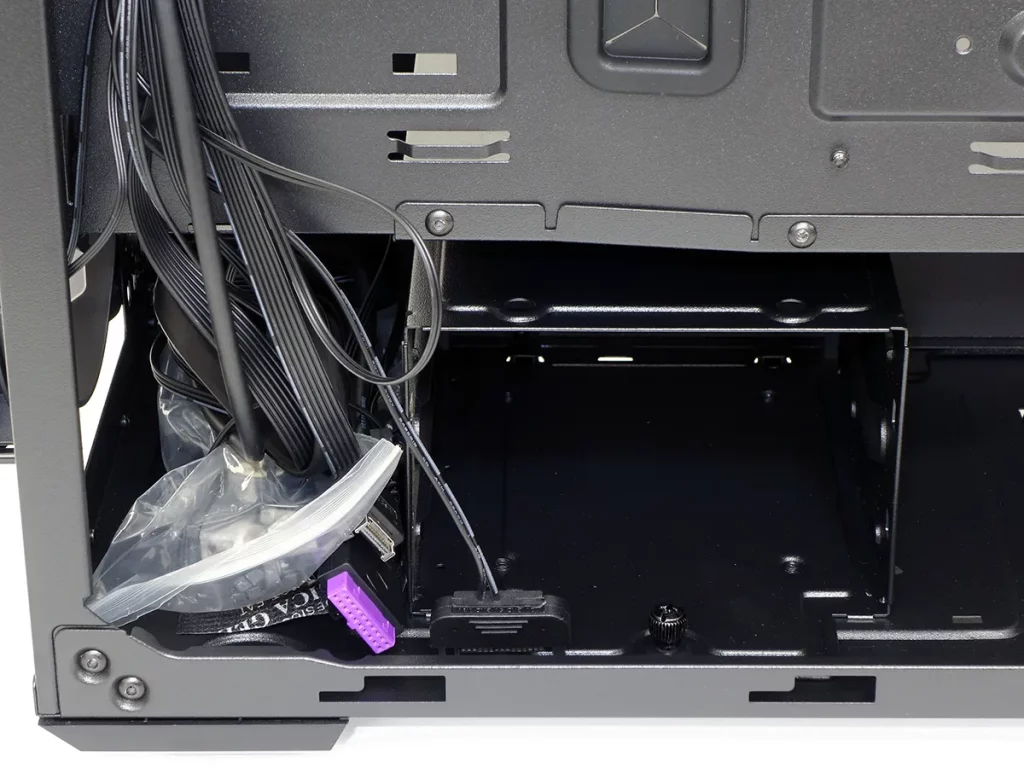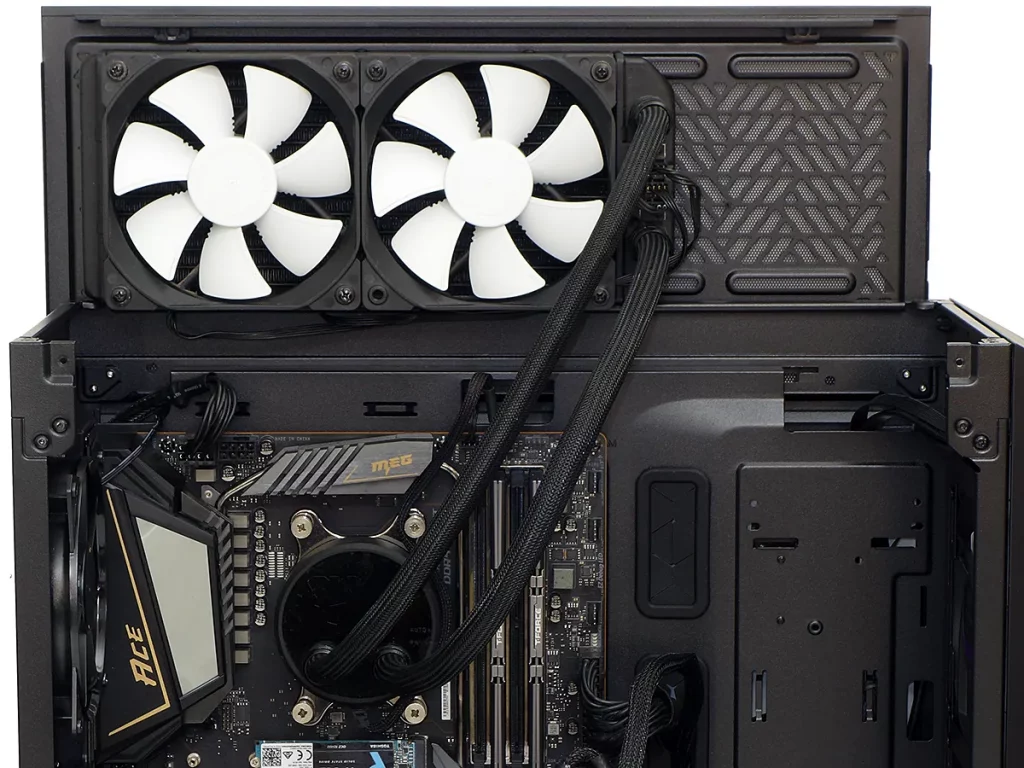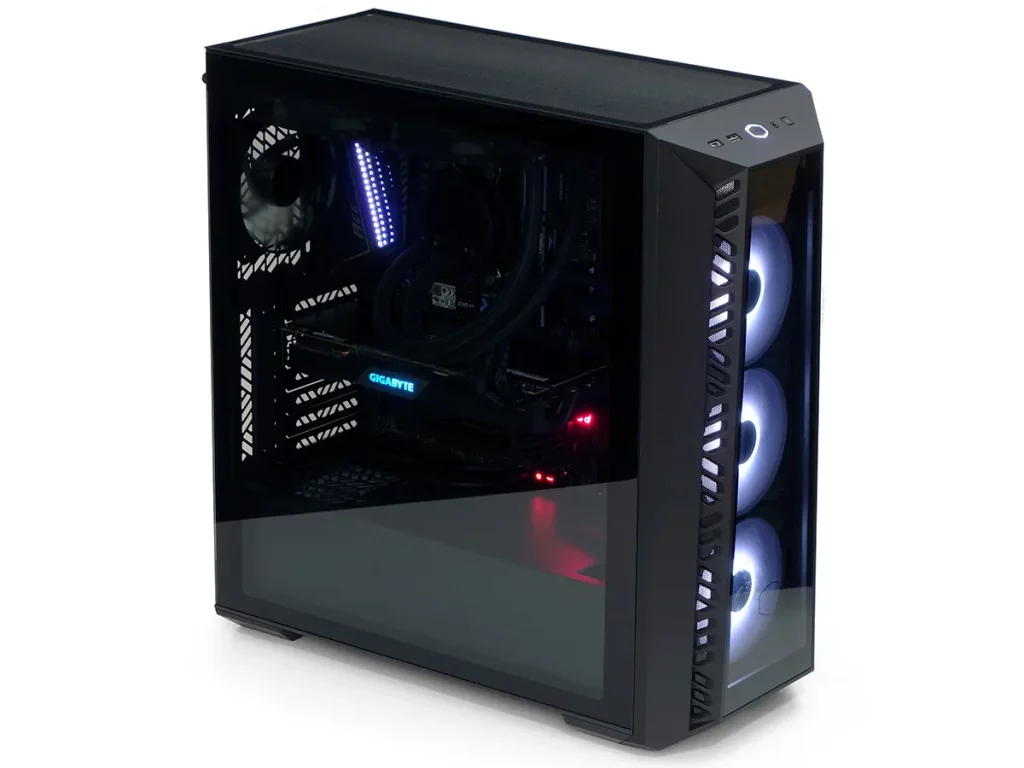Cooler Master MasterBox 520 (2022 Edition) Review
What does a company do when it believes a product so good that it deserves an encore? The MasterBox 520 has been around four at least four years, yet it wasn’t until September of this year that we first spotted its latest incarnations:

| Cooler Master MasterBox 520 MB520-KGNN-S01 | |||
| Type | Mid-Tower | Included Fans | (3) 120mm Front (ARGB) |
| Motherboard Support | SSI CEB, ATX, Micro ATX, Mini ITX | Front Fan Mounts | (3) 120mm or (2) 140mm |
| Max Motherboard Depth | 10.7″ (27.2 cm) | Rear Fan Mounts | (1) 120mm |
| Dimensions (HxWxD) | 19.63 x 8.25 x 19.5″ (49.8 x 21.0 x 49.5 cm) | Top Fan Mounts | (3) 120mm or (2) 140mm |
| Air Cooler Clearance | 165mm | Bottom Fan Mounts | X |
| Card Length | 410mm measured & rated | Side Fan Mounts | X |
| Power Supply Format | PS/2: 235mm measured, rated 200mm | Top Rad. Clearance | 57mm vertical, 19/39mm horizontal |
| Weight | 17.7 lbs (8.03 kg) | Front Rad. Clearance | 75mm |
| External Bays | X | Front Filter | X |
| Internal Bays | (2) 3.5″, (3) 2.5″ | Top Filter | Magnetic perforated sheet |
| Card Slots | 7 | Bottom Filter | Slide-out (from rear) nylon mesh |
| Ports/Jacks | (1) Gen2 Type-C, (1) Gen1 Type A, Head/Mic Combo | Damping | None |
| Other | LED Controller | Price | $160 |
Get it at Amazon

(click for availability)
We used the plural form of incarnation because the case is available in the buyer’s choice of black or white finish and glass or mesh face panels, and while the mesh qualifies as a new feature the version that we received doesn’t even have it. Even the ARGB has already been available since 2011 as the MB520 ARGB model number MCB-B520-KGNN-RGA. So, what makes the new MB520-KGNN-S01 so different from its forbearers?

For this generation of cases, Cooler Master replaced one of the USB3 Gen1 ports with USB3 Gen2. That’s all. Getting it to Gen2 speed required a new port panel and additional cable, but other than perhaps an alternative texture on the face panel’s frame, that’s it. Oh, and the way to differentiate the new model’s name is to call it the MasterBox 520 and never the MB520, even though the MasterBox 520’s model number includes the term MB520 whereas the earlier MB520 ARGB’s model number did not. So that’s not confusing (heavy sarcasm).

Not to forget why Cooler Master keeps rehashing this thing: It would be extremely difficult for the company to make a new case this good, this cheaply. The features are mostly mid-market, the finish is high quality, the materials are mid-market, and development cost have already been recovered.

By “mostly” mid-market features, we might be referring to the easy slide-out dust filter under the power supply and the distinct lack of any removable dust filter for the face. We instead get embedded mesh panels that can only be brushed or blown clean and will probably look at least a little dirty most of the time for most users. Having grown accustomed to having an air compressor at hand, we’d hate to be the one who had to brush these vents out instead of blowing them.

Both the front and top of the MasterBox 520 support the builder’s choice of three 120mm or two 140mm fans, and the company even includes three ARGB fans mounted to its face panel. As for the top, 120mm fans are offset enough to allow some liquid cooling system to motherboard component overlap, but the case has enough space above the board to fit radiator and fan combos up to 57mm thick without relying on such overlap.

The MasterBox 520 has none of the SSD tray brackets that are found on the power supply tunnels of so many competitors, but we can see where one might have been placed at the front of the motherboard tray in an alternative configuration. We also see two sets of holes for its SSD mounting system and a 75mm gap at the front of the power supply tunnel for installing oversized radiators. Also notice the small inward step of the motherboard tray, which we’ll discuss later.

A quick look underneath reveals nothing but a power supply vent along with the filter’s slide brackets for features, but a screw poking out near the front and a second threaded hole nearby show that the internal drive cage can be moved back by either 25mm or 1” (we didn’t fuss about figuring out that last 0.4mm).

The drive cage at the front of the power supply tunnel fits two 3.5” units internally and has holes for a 2.5” part on its top. A screw prevents the cage from sliding out of its mounting slots, but we can’t figure out why Cooler Master includes a second screw hole to allow it to be moved rearward: Its default position offers as much front panel radiator clearance as the gap above (75mm), and moving it rearward decreases power supply space.

An ARGB controller serves five ARGB lighting headers and also acts as a hub for up to four 3-pin fans. It features fourteen programmed color patterns plus ARGB passthrough from a motherboard’s ARGB header, but when we connected the ARGB lead to our motherboard we were no longer able to access the programmed modes. The controller also repurposes the case’s reset button: With both the reset button acting as a mode switch and our motherboard sending an ARGB signal, the case’s reset button loses its function(s).

Test Hardware Configuration
| System Configuration | |
| CPU | AMD Ryzen 7 3700X: 8 cores/ 16 threads, 32MB L3 Cache O/C to 4.20 GHz (42x 100 MHz) at 1.3625 V Core |
| CPU Cooler | Fractal Design Celsius S24 2x 120mm Closed-Loop Liquid Cooler |
| Motherboard | MSI X570 Ace: AMD X570, Socket AM4 |
| RAM | PNY XLR8 MD32GK2D4320016XR: 2x 16GB DDR4-3200 T-Force Vulcan Z TLZGD416G3200HC16CDC0 DDR4-3200 |
| Graphics | Gigabyte GeForce RTX 2070 Gaming OC 8G: GeForce RTX 2070 1815 MHz GPU, GDDR6-14000, Maximum Fan When Listed |
| Hard Drives | Toshiba OCZ RD400 256GB NVMe SSD |
| Sound | Integrated HD Audio |
| Network | Integrated Gigabit Networking |
| Power | Corsair AX860i: ATX12V v2.3, EPS12V, 80 PLUS Platinum |
| Test Configuration | |
| Load Software | AIDA 64 Engineer Version 6.00.5100, Stress CPU, FPU, Cache, GPU |
| H/W Monitoring | HWiNFO64 v6.28-4200 |
| SPL Monitoring | Galaxy CM-140 SPL Meter: Tested at 1/4 m, corrected to 1 m (-12 dB) |
Installation hardware includes four rails to install two 3.5” drives, twelve grommets to install three 2.5” drives, several cable ties, and a hardware pack with the necessary pins for mounting 2.5” drives to those grommets. Other hardware includes motherboard screws and a socket adapter for removing and reinstalling hexagonal standoffs using a #2 Phillips screwdriver.

The MasterBox 520’s dual-port USB3 Gen1 cable serves only a single port, since Cooler Master decided to replace the front panel’s second Type A port with a Gen2 Type-C. The reset button lead is also missing in this photo since Cooler Master repurposed that as an ARGB function controller.

The MasterBox 520 features a removable top panel that allows builders to more-easily rout cables over the top of the motherboard, though this feature wasn’t particularly useful to us since we attached our radiator after installing those cables.

While the MasterBox 520 provides ample room for our full ATX hardware, the excess space at the front of the board is partially closed off by the previously-mentioned inward step of the motherboard tray. Cooler Master rates it as fitting boards up to 10.7” deep, which appears a safe estimate.

One of the nicest features of the MasterBox 520 is now nice it looks all lit up.

The MasterBox 520’s charted CPU temperature falls directly underneath the lines of its Gamdias and Montech competitors, so that the only two standouts are the TD500 Mesh’s greater performance and the FSP CMT510’s lesser performance.

The same analysis applies mostly to voltage regulator temperature, though the bunch in the middle is slightly more spread out. We looked back at the numbers to verify that the MasterBox 520 and Talos E3 fall directly in the center of that group.

Chipset temperatures mix the results up a bit more, but the MasterBox 520 still shares the middle position with one of the competing cases.

The MasterBox finally stands out a bit in our last temperature measurement, the GPU, but not in a good way: It showed slightly higher temperatures than four of its five competitors.

The MasterBox 520 is also the third quietest of the group. Or is that the fourth noisiest? The grouping is so close that the only two standouts are the noisier TD500 Mesh and the quieter Air 900 ARGB.

With only the MasterBox TD500 Mesh offering noticeably better cooling (at greater noise) and the Air 900 offering noticeably less noise (at higher chipset temperature), the MasterBox 520 has no performance issues to discuss. Users will choose it, or not, based on the hardware it supports, the features it offers, and the price it costs.
| Cooler Master MasterBox 520 MB520-KGNN-S01 | |
| Pros: | Cons: |
|
|
| The Verdict: | |
| The MasterBox 520 adds USB3 Gen2 Type-C to the features of its MB520 ARGB predecessor, but naming issues make it almost impossible to find among numerous previous-generation models. | |
Get it at Amazon

(click for availability)
Our search for the MasterBox 520 turned up dozens of examples of preceding parts being sold under its name and even “discontinued” models being advertised under the new model’s specifications. Using the model number in quotation marks as a search term at least got us to foreign listings at $160 AU (approximately $102 US). With a feature set that places it in the $99 category, we’ll have to see that price before we can even think about whether or not we’d pick it over any other similarly-performing, similarly-priced parts.
